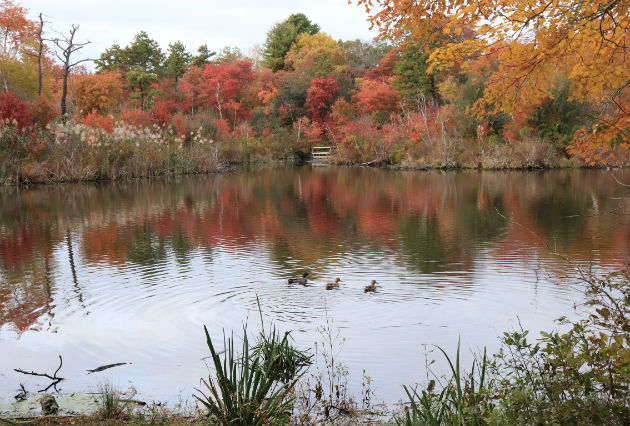Legs weak, I emerged from a forest of rust and gold just in time to see a blood orange horizon. As the sun set, the Great South Bay gleamed with all the colors of autumn, as bright and vivid as the surrounding foliage. A brisk gust brushed my face, contrasting to the warm feeling of catharsis that washed over me – I finished the Greenbelt Trail.
Hiking Long Island in the fall is a brilliant way to take in the foliage: it’s healthy, cheap and you can bring the whole clan. A trek on the Greenbelt Trail, one of Long Island’s longest hikes, offers a scenic opportunity to fully appreciate the season and bask in the beauty of the changing trees.
Starting at Sunken Meadow State Park, the Greenbelt stretches from the Long Island Sound to the Great South Bay – a full 32.5 miles. The twists and turns take you through the various landscapes of the island, from the hilly bluffs of the north shore to the quiet marshes of the south. Along the way, you’ll stumble upon ponds, pines and some hidden history. From shore to shore, it took me about 9 hours.
From Sunken Meadow, head south along the Nissequogue River. This tranquil wetland trail is teeming with life, contrasted by the barren brick buildings of Kings Park Psychiatric Center. The crawling vines and rusty railings are especially eerie amongst the fading leaves.
Keep following the bends of the Nissequogue until you reach Caleb Smith State Park. As you wander the upland woods, ospreys and warblers flying overhead, you’ll forget that this wildlife preserve is nestled in the heart of a suburb.
The backcountry splendor continues just across the road at Blydenburgh County Park, where the Nissequogue forks into two vast freshwater ponds. While crossing over, you can stop by the Long Island Greenbelt Trail Conference headquarters and thank them for the continuous work they put in to maintain these trails.
Rich valleys are not the only thing to discover at Blydenburgh; you can also see the historic district, comprised of farm and mill buildings that date back as far as 1798. Travel east along the swan-inhabited waters of New Mill Pond until you hit paved road once more.
Wave to the neighbors as you meander through backroads and backwoods, experiencing a more intimate side of suburbia as you head towards Hidden Pond Park. Here you will have to traverse the Ronkonkoma moraine – a glacial ridge that runs along the jagged spine of the fish-shaped island. On the other side of your ascent, cross the main artery of metropolis – the Long Island Expressway. With only one-third of the journey remaining, you’ve officially left the land of rolling hills and started the flatland trek towards the southern sea.

At Lakeland County Park, rest your feet inside the gazebo, then duck back into the shade of red maple and sassafras trees. Walk the boardwalk until you reach Honeysuckle Pond, where you might catch a glimpse of turtle heads poking out the surface.
Next stop, Connetquot River State Park, the essence of the Greenbelt’s natural wonder. Connetquot’s diverse ecology consists of woodlands, wetlands and pine barrens. The towering pines and oak brush plains are home to white-tailed deer, red foxes, a cornucopia of multi-colored birds and many other curious creatures. You may even come across a horse (hopefully with a human saddled on top.)
A wellspring of wilderness, this nearly 3,500-acre refuge will transport you to a pre-civilized island, away from the roar of engines and the rush of life. The preserve also contains a hatchery abounding with trout, in the river for which the park was named. The term “Connetquot” comes from the Secatogue tribe phrase for Great River, a tribute to the native roots of the area. The park ends at Sunrise Highway, but there’s an underpass that can take you to the other side. From here, follow the Great River as it flows through ponds and marshes, snaking its way to the boggy timberland of Hecksher State Park, where it empties into the bay.
Besides the minor inconvenience of walking a few side roads, the Greenbelt Trail is an adventure that every serious Long Island hiker should consider. Hiking Long Island in the fall, when the cold has forced nature’s nuisances such as mosquitos and ticks back into hiding, is arguably the best time to go. If you’re looking for a quicker hike, start anywhere along the trail, or try out the shorter Nassau-Suffolk Greenbelt.
Starting at the Massapequa Preserve, the Nassau-Suffolk Greenbelt stretches north for 19.5 miles. Forge ahead and travel back in time as you walk in the footsteps of Walt Whitman. A short walk east of the main trail will bring you to West Hills Nature Preserve, where Whitman used to walk up to Jayne’s Hill, Long Island’s highest peak. Not interested in historic detours? Finish up at Cold Spring Harbor just before dusk and watch the sunset cast its colors across the Sound.
While the Greenbelt Conference, a non-profit volunteer organization, does their best to maintain these trails, some signs may be hard to follow. Your best bet is to purchase an official map. Plus, you’ll be contributing to a great cause! The group builds hiking trails in an effort to preserve Long Island’s open spaces. Hiking Long Island is the perfect excuse to get outside, get active, support your local habitat and witness some beautiful views of fall foliage along the way.
Tell us about your favorite places to hike on Long Island, or anywhere in the Northeast, in the comments.
Discover more great nearby hikes.













